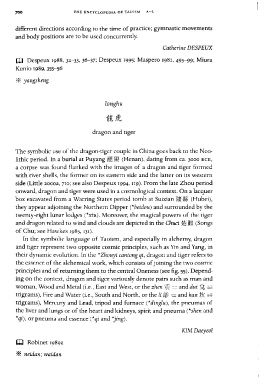Page 742 - The Encyclopedia of Taoism v1_A-L
P. 742
THE ENCYCLOPEDIA OF TAOISM A-L
different directions according to the time of practice; gymnastic movements
and body positions are to be used concurrently.
Catherine DESPEUX
W Despeux 1988, 32-33, 36-37; Despeux 1995; Maspero 1981, 495--99; Miura
Kunio 1989, 355-56
* yangsheng
longhu
~tJt
dragon and tiger
The symbolic use of the dragon-tiger couple in China goes back to the Neo-
lithic period. In a burial at Puyang rt ~ (Henan), dating from ca. 3000 BCE,
a corpse was found flanked with the images of a dragon and tiger formed
with river shells, the former on its eastern side and the latter on its western
side (Little 2000a, 710; see also Despeux 1994, II9). From the late Zhou period
onward, dragon and tiger were used in a cosmological context. On a lacquer
box excavated from a Warring States period tomb at Suixian !)j!M\ (Hubei),
they appear adjoining the Northern Dipper (*beidou) and surrounded by the
twenty-eight lunar lodges (*xiu). Moreover, the magical powers of the tiger
and dragon related to wind and clouds are depicted in the Chuci ~ ~ (Songs
of Chu; see Hawkes 1985, 131).
In the symbolic language of Taoism, and especially in alchemy, dragon
and tiger represent two opposite cosmic principles, such as Yin and Yang, in
their dynamic evolution. In the *Zhouyi can tong qi, dragon and tiger refers to
the essence of the alchemical work, which consists of joining the two cosmic
principles and of returning them to the central Oneness (see fig. 55). Depend-
ing on the context, dragon and tiger variously denote pairs such as man and
woman, Wood and Metal (i.e., East and West, or the zhen Il~~ == and dui ft =
trigrams), Fire and Water (i.e., South and North, or the li ~jt = and kan :I;A: ==
trigrams), Mercury and Lead, tripod and furnace (*dinglu), the pneumas of
the liver and lungs or of the heart and kidneys, spirit and pneuma (*shen and
*qi), or pneuma and essence (*qi and *jing).
KIM Daeyeol
* neidan; waidan

